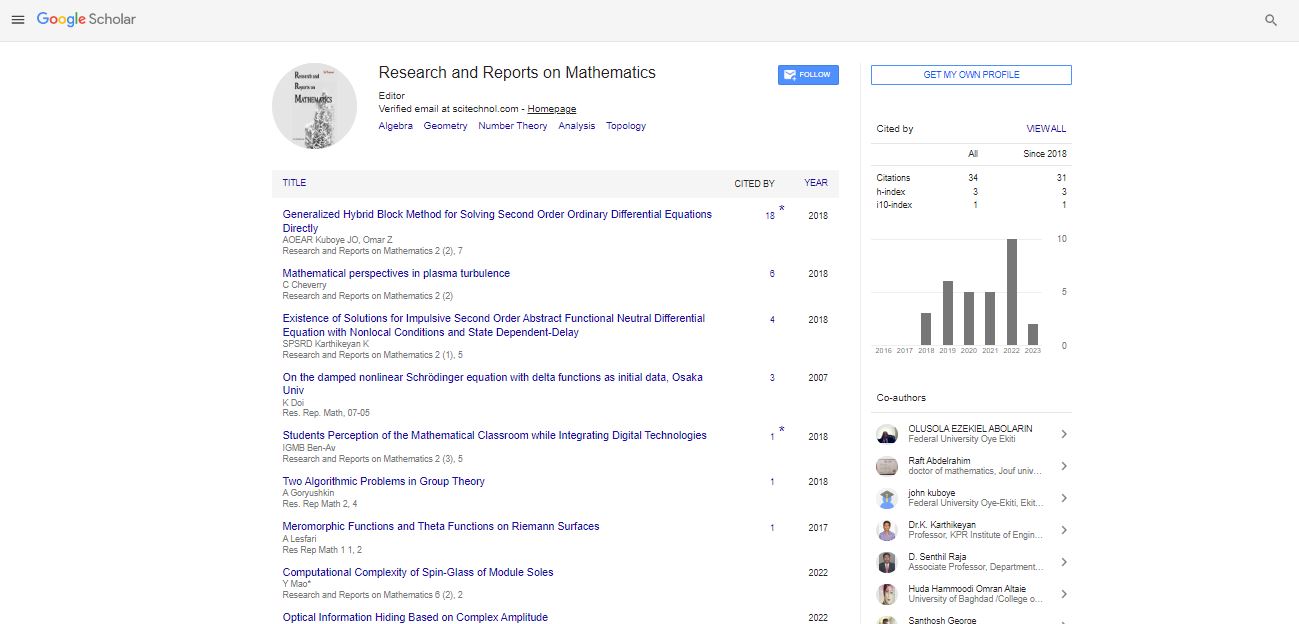Opinion Article, Res Rep Math Vol: 7 Issue: 5
Elliptic Curves and Modular Forms: Interconnections in Modern Number Theory
Grami Korenaga*
1Department of Mathematics, Kasetsart University, Chatuchak Bangkok, Thailand
*Corresponding Author: Grami Korenaga,
Department of Mathematics, Kasetsart
University, Chatuchak Bangkok, Thailand
E-mail: korengra@ku.ac.th
Received date: 27 November, 2023, Manuscript No. RRM-24-124958;
Editor assigned date: 29 November, 2023, PreQC No. RRM-24-124958 (PQ);
Reviewed date: 14 December, 2023, QC No.RRM-24-124958;
Revised date: 21 December, 2023, Manuscript No.RRM-24-124958 (R);
Published date: 28 December, 2023, DOI: 07.4172/rrm.1000216
Citation: Korenaga G (2023) Elliptic Curves and Modular Forms: Interconnections in Modern Number Theory. Res Rep Math 7:5.
Description
Number theory and analytical geometry stand as two pillars in the vast landscape of mathematics, each contributing unique insights and tools to our understanding of the mathematical universe. Number theory delves into the properties and relationships of integers, unlocking the secrets of prime numbers and paving the way for cryptography. On the other hand, analytical geometry provides a geometric approach to algebraic problems, connecting algebra with geometry and transforming abstract equations into visual representations. Number theory, often referred to as the "Queen of Mathematics," focuses on the study of integers and their inherent properties. Its roots trace back to ancient civilizations, with the Greeks laying the groundwork for early number-theoretic investigations. However, it wasn't until the 17th and 18th centuries that number theory began to flourish with the works of mathematicians like Fermat and Euler. Today, number theory plays a central role in cryptography, coding theory, and the foundation of modern algebraic structures.
One of the central themes in number theory is the study of prime numbers integers greater than 1 that have no positive divisors other than 1 and themselves. The distribution and properties of prime numbers have captivated mathematicians for centuries, leading to the formulation of the Prime Number Theorem and the Riemann Hypothesis. Prime numbers lie at the heart of modern cryptography, where their unique properties form the basis for secure communication systems and encryption algorithms. Modular arithmetic, a key concept in number theory, involves the study of arithmetic operations performed within a fixed modulus. This modular approach provides a powerful tool for solving problems related to congruences and remains foundational in various cryptographic algorithms. The Chinese Remainder Theorem, for instance, is an elegant application of modular arithmetic that finds widespread use in computer science and information security.
Diophantine equations, named after the ancient Greek mathematician Diophantus, involve finding integer solutions to polynomial equations. These equations have applications in diverse areas, from number theory to cryptography. The study of Diophantine equations deepens our understanding of the interplay between algebra and number theory, showcasing the elegance and complexity of mathematical problem-solving. Analytical geometry, pioneered by René Descartes in the 17th century, revolutionized the way mathematicians approached geometric problems. By introducing a coordinate system that assigns numerical values to points in space, analytical geometry bridges the gap between algebra and geometry. This powerful fusion of disciplines enables mathematicians to represent geometric shapes algebraically and solve complex problems through the lens of coordinate systems.
The Cartesian coordinate system, the cornerstone of analytical geometry, assigns numerical coordinates to points in space. The x, y, and z axes create a framework for describing the position of points, lines, and shapes with precision. Analytical geometry provides a visual and intuitive approach to problem-solving, allowing mathematicians to graph functions, analyze curves, and explore the relationships between geometric entities. The study of conic sections circles, ellipses, hyperbolas, and parabolas represents a fundamental aspect of analytical geometry. By manipulating equations, mathematicians can derive the properties and relationships of these curves. Conic sections find applications in physics, engineering, and astronomy, offering a geometric perspective on the trajectories of celestial bodies and the design of optical systems.
Applications
The association of number theory and analytical geometry finds practical applications in physics and engineering. The trajectory of a projectile, the dynamics of a mechanical system, and the design of electrical circuits all involve the interplay of number theory and analytical geometry. By translating physical phenomena into mathematical models, scientists and engineers leverage these mathematical tools to predict behavior, optimize designs, and advance technological innovation. Surprisingly, number theory and analytical geometry share more connections than one might initially perceive. The study of elliptic curves, for example, involves both number theory and analytical geometry. Elliptic curve cryptography, a branch of cryptography built on the properties of these curves, showcases the integration of number theory and analytical geometry in creating secure communication protocols.
Conclusion
In conclusion, number theory and analytical geometry, though distinct in their focus, form a harmonious symphony within the realm of mathematics. Number theory's exploration of integers, primes, and modular arithmetic merges seamlessly with analytical geometry's geometric representation of algebraic equations. Together, they underpin the foundations of cryptography, contribute to advancements in physics and engineering, and offer a rich tapestry of mathematical beauty. As we navigate the intricacies of number theory and analytical geometry, we unveil not only the elegance of abstract concepts but also the tangible applications that shape our technological landscape. Indeed, these two branches stand as testament to the enduring power and versatility of mathematics in unraveling the mysteries of the universe.
 Spanish
Spanish  Chinese
Chinese  Russian
Russian  German
German  French
French  Japanese
Japanese  Portuguese
Portuguese  Hindi
Hindi 